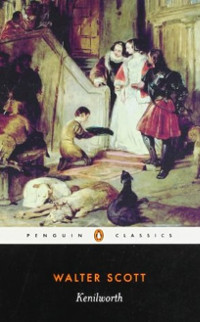
Kenilworth, by Sir Walter Scott (Scottish classic)
“In the court of Elizabeth I, Robert Dudley, Earl of Leicester, is favoured above all the noblemen of England. It is rumoured that the Queen may chose him for her husband, but Leicester has secretly married the beautiful Amy Robsart. Fearing ruin if this were known, he keeps his lovely young wife a virtual prisoner in an old country house. Meanwhile Leicester’s manservant Varney has sinister designs on Amy, and enlists an alchemist to help him further his evil ambitions. Brilliantly recreating the splendour and pageantry of Elizabethan England, with Shakespeare, Walter Ralegh and Elizabeth herself among its characters, Kenilworth (1821) is a compelling depiction of intrigue, power struggles and superstition in a bygone age.”
The tension between possessing a title of nobility and being noble in mind and heart lies at the center of Kenilworth. From the beginning of the novel, Scott portrays the former suitor of Amy Robsart, the gentleman Tressilian, as possessing nobility of mind and heart. We first meet Tressilian at an inn, where he is seeking information about the whereabouts of Amy on behalf of her father. His features have a “meditative and tranquil cast,” and he is “dressed with plainness and decency, yet bearing an air of ease which almost amounted to dignity, and which seemed to infer that his habit was rather beneath his rank.” While he is at the inn, the proprietor makes this observation about Tressilian to his nephew Michael Lambourne, who ends up in the employ of the story’s villain, Richard Varney:
But how brave thou be’st, lad! To look on thee now, and compare thee with Master Tressilian here, in his sad-coloured riding-suit, who would not say that thou wert the real gentleman and he the tapster’s boy?”
“Troth, uncle,” replied Lambourne, “no one would say so but one of your country-breeding, that knows no better. I will say, and I care not who hears me, there is something about the real gentry that few men come up to that are not born and bred to the mystery. I wot not where the trick lies; but although I can enter an ordinary with as much audacity, rebuke the waiters and drawers as loudly, drink as deep a health, swear as round an oath, and fling my gold as freely about as any of the jingling spurs and white feathers that are around me, yet, hang me if I can ever catch the true grace of it, though I have practised an hundred times. The man of the house sets me lowest at the board, and carves to me the last; and the drawer says, ‘Coming, friend,’ without any more reverence or regardful addition. But, hang it, let it pass; care killed a cat. I have gentry enough to pass the trick on Tony Fire-the-Faggot, and that will do for the matter in hand.”
Chapter 3
Lambourne has had enough experience in the world to recognize that Tressilian is an authentic gentleman and that he is not. Lambourne also knows that while he could never deceive a true gentleman into accepting him as an equal, he can fake it just enough persuade Tony Foster, an old friend of his, to give him a glimpse of the mysterious woman who, according to rumor, is residing at Cumnor Place, the country house Foster manages.
Tressilian believes the woman in question is Amy and uses his acquaintance with Lambourne to get into Cumnor Place. Amy, blinded by her own ambition to secure a title, has irrevocably chosen a man possessing a title of nobility over Tressilian and is not at all happy to see him, but she later defends him in an interesting conversation with Varney about the differences between “rustic truth” and “courtly compliment”:
“He is the freest, the most open, the most gentle heart that breathes. My [husband] ever excepted, I know not one to whom falsehood is more odious than to Tressilian.” . . .
“Tressilian’s conscience is of other mould—the world thou speakest of has not that which could bribe him from the way of truth and honour; and for living in it with a soiled fame, the ermine would as soon seek to lodge in the den of the foul polecat.”
Chapter 6
Later in the novel, when an agent of Tressilian comes to Cumnor Place to help Amy, she says this about Tressilian:
“If he be a friend of Tressilian, . . . I will commit myself to his charge as to that of an angel sent from heaven; for than Tressilian never breathed mortal man more free of whatever was base, false, or selfish. He forgot himself whenever he could be of use to others.”
Chapter 23
Unfortunately for Amy, she is mistaken about her secret husband’s commitment to truth. While she is hidden in Cumnor Place, he hosts a lavish party at his palace Kenilworth, where he courts Queen Elizabeth. Unlike Lambourne, who hasn’t the sophistication to pass himself off as a gentleman by birth or in character, Leicester’s polish and courtly charm fools even Queen Elizabeth into believing that he is as noble in mind and heart as he is in worldly rank. Scott describes the conflict between the Earl of Leicester’s appearance and conscience in this way:
Leicester, who glittered like a golden image with jewels and cloth of gold, rode on her Majesty’s right hand, as well in quality of her host as of her master of the horse. . . . He was bareheaded as were all the courtiers in the train; and the red torchlight shone upon his long, curled tresses of dark hair, and on his noble features, to the beauty of which even the severest criticism could only object the lordly fault, as it may be termed, of a forehead somewhat too high. On that proud evening those features wore all the grateful solicitude of a subject, to show himself sensible of the high honour which the Queen was conferring on him, and all the pride and satisfaction which became so glorious a moment. Yet, though neither eye nor feature betrayed aught but feelings which suited the occasion, some of the Earl’s personal attendants remarked that he was unusually pale, and they expressed to each other their fear that he was taking more fatigue than consisted with his health.
Varney followed close behind his master, as the principal esquire in waiting, and had charge of his lordship’s black velvet bonnet, garnished with a clasp of diamonds and surmounted by a white plume. He kept his eye constantly on his master, and, for reasons with which the reader is not unacquainted, was, among Leicester’s numerous dependants, the one who was most anxious that his lord’s strength and resolution should carry him successfully through a day so agitating. For although Varney was one of the few, the very few moral monsters who contrive to lull to sleep the remorse of their own bosoms, and are drugged into moral insensibility by atheism, as men in extreme agony are lulled by opium, yet he knew that in the breast of his patron there was already awakened the fire that is never quenched, and that his lord felt, amid all the pomp and magnificence we have described, the gnawing of the worm that dieth not.
Chapter 30
At the end of the novel, when the truth finally comes out, the Earl of Leicester, in shame, begs for mercy and describes himself as a crushed worm. Queen Elizabeth observes that a snake is a nobler reptile and the more accurate likeness. Leicester has mortified Elizabeth, and her judgment in response to this affront shows her to be a character who possesses both a title of nobility and the quality of being noble in mind and heart.
Kenilworth Castle itself becomes the primary symbol in the novel of the fleeting nature of worldly ambition and rank. Scott, after describing the grandeur of Kenilworth Castle—rendered even more spectacular by Leicester in preparation for the arrival of Queen Elizabeth—compares the past to the present and the enduring happiness of those who are virtuous and truly noble:
Beyond the lake lay an extensive chase, full of red deer, fallow deer, roes, and every species of game, and abounding with lofty trees, from amongst which the extended front and massive towers of the Castle were seen to rise in majesty and beauty. We cannot but add, that of this lordly palace, where princes feasted and heroes fought, now in the bloody earnest of storm and siege, and now in the games of chivalry, where beauty dealt the prize which valour won, all is now desolate. The bed of the lake is but a rushy swamp; and the massive ruins of the Castle only serve to show what their splendour once was, and to impress on the musing visitor the transitory value of human possessions, and the happiness of those who enjoy a humble lot in virtuous contentment.
Chapter 25
Scott wrote these words more than two centuries after the Earl of Leicester entertained Queen Elizabeth at Kenilworth Castle in 1575. It’s easy to compare the lavishness of Kenilworth Castle in 1575 to it’s ruins now and come to a conclusion like Scott’s, but it’s not so easy to reject the prestige and lavishness of today’s world to be noble in heart and mind, especially when such a course can make life difficult. One of the interesting things about Scott’s Kenilworth is that the characters who are noble in mind and heart don’t necessarily end up with a happy, long life in the material sense. The novel feels like escapism in the way it’s crafted, but the ending, while satisfying on many levels, is stark. For the characters of Kenilworth, as well as for us, nobility of mind and heart grants its own reward of tranquility and spiritual peace. Those who choose to pursue nobility of rank at the expense of the other may gain material comforts and prestige, but they will also experience the disturbance of mind and heart that Leicester observes for himself:
“Conscience, thou art a bloodhound, whose growl wakes us readily at the paltry stir of a rat or mouse as at the step of a lion.”
Chapter 17
The photo of Kenilworth Castle is credited to Paul Johnson under a CC BY-SA 3.0 license.



